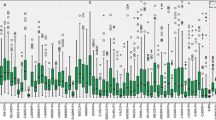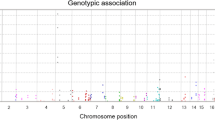Abstract
With the advent of next-generation sequencing technology, SNP markers are being explored as a useful alternative to conventional capillary electrophoresis–based STR typing. Low mutation rate and short-sized amplicons are added advantages of SNP markers over the STRs. However, to achieve a sufficient level of discrimination among individuals, a higher number of SNPs need to be characterized simultaneously. Hence, the NGS technique is highly useful to analyze a sufficiently higher number of SNPs simultaneously. Though the technique is in its nascent stage, an attempt has been made to assess its usability in the central Indian population by analyzing 124 SNPs (90 autosomal and 34 Y-chromosome) in 95 individuals. Various quality parameters such as locus balance, locus strand balance, heterozygosity balance, and noise level showed a good quality sequence obtained from the Ion GeneStudio S5 instrument. Obtained frequency of SNP alleles ranged from 0.001 to 0.377 in autosomal SNPs. rs9951171 was found to be the most informative SNP in the studied population with the highest PD and lowest MP value. The cumulative MP of 90 SNPs was found to be 4.76698 × 10–37. Analysis of 34 Y-chromosome SNPs reveals 11 unique haplogroups in 54 male samples with R1a1 as the most frequent haplogroup found in 22.22% of samples. Interpopulation comparison by FST analysis, PCA plot, and STRUCTURE analysis showed genetic stratification of the studied population suggesting the utility of SNP markers present in the Precision ID Identity Panel for forensic demands of the Indian population.





Similar content being viewed by others
References
Schneider PM (2012) Beyond STRs: the role of diallelic markers in forensic genetics. Transfus Med Hemother 39:176–180. https://doi.org/10.1159/000339139
Nelson MR, Marnellos G, Kammerer S, Hoyal CR, Shi MM, Cantor CR, Braun A (2004) Large-scale validation of single nucleotide polymorphisms in gene regions. Genome Res 14:1664–1668. https://doi.org/10.1101/gr.2421604
Yousefi S, Abbassi-Daloii T, Kraaijenbrink T, Vermaat M, Mei H, van’t Hof P, van Iterson M, Zhernakova DV, Claringbould A, Franke L, ‘t Hart LM, Slieker RC, van der Heijden A, de Knijff P, BIOS consortium, ‘t Hoen PAC (2018) A SNP panel for identification of DNA and RNA specimens. BMC Genomics 19:90. https://doi.org/10.1186/s12864-018-4482-7
Budowle B, van Daal A (2018) Forensically relevant SNP classes. BIOTECHNIQUES 44:5. https://doi.org/10.2144/000112806
Chakraborty R, Stivers DN, Su B, Zhong Y, Budowle B (1999) The utility of short tandem repeat loci beyond human identification: implications for development of new DNA typing systems. Electrophoresis 20:1682–1696
Diepenbroek M, Bayer B, Schwender K, Schiller R, Lim J, Lagacé R, Anslinger K (2020) Evaluation of the Ion AmpliSeqTM PhenoTrivium panel: MPS-based assay for ancestry and phenotype predictions challenged by casework samples. Genes 11:1398. https://doi.org/10.3390/genes11121398
Oldoni F, Bader D, Fantinato C, Wootton SC, Lagacé R, Kidd KK, Podini D (2020) A sequence-based 74plex microhaplotype assay for analysis of forensic DNA mixtures. Forensic Sci Int Genetics 49:102367. https://doi.org/10.1016/j.fsigen.2020.102367
Butler JM, Budowle B, Gill P, Kidd KK, Phillips C, Schneider PM, Vallone PM, Morling N (2008) Report on ISFG SNP Panel Discussion. Forensic Sci Int Genet Suppl Ser 1:471–472. https://doi.org/10.1016/j.fsigss.2007.10.159
Moorjani P, Thangaraj K, Patterson N, Lipson M, Loh PR, Govindaraj P, Berger B, Reich D, Singh L (2013) Genetic evidence for recent population mixture in India. Am J Hum Genet 93:422–438. https://doi.org/10.1016/j.ajhg.2013.07.006
Excoffier L, Lischer HE (2010) Arlequin suite ver 3.5: a new series of programs to perform population genetics analyses under Linux and Windows. Mol Ecol Resour 10:564–567. https://doi.org/10.1111/j.1755-0998.2010.02847.x
Gouy A, Zieger M (2017) STRAF - a convenient online tool for STR data evaluation in forensic genetics. Forensic Sci Int Genet 30:148–151. https://doi.org/10.1016/j.fsigen.2017.07.007
Avila E, Felkl AB, Graebin P, Nunes CP, Alho CS (2019) Forensic characterization of Brazilian regional populations through massive parallel sequencing of 124 SNPs included in HID ion Ampliseq Identity Panel. Forensic Sci Int Genet 40:74–84. https://doi.org/10.1016/j.fsigen.2019.02.012
Kumar S, Stecher G, Tamura K (2016) MEGA7: molecular evolutionary genetics analysis version 7.0 for bigger datasets. Mol Biol Evol 7:1870–1874. https://doi.org/10.1093/molbev/msw054
van der Heijden S, de Oliveira SJ, Kampmann ML, Børsting C, Morling N (2017) Comparison of manual and automated AmpliSeqTM workflows in the typing of a Somali population with the Precision ID Identity Panel. Forensic Sci Int Genet 31:118–125. https://doi.org/10.1016/j.fsigen.2017.09.009
Petrovick MS, Boettcher T, Fremont-Smith P, Peragallo C, Ricke DO, Watkins J, Schwoebel E (2020) Analysis of complex DNA mixtures using massively parallel sequencing of SNPs with low minor allele frequencies. Forensic Sci Int Genet 46:102234. https://doi.org/10.1016/j.fsigen.2020.102234
Ricke DO, Fremont-Smith P, Watkins J, Stankiewicz S, Boettcher T, Schwoebel E (2019) Estimating Individual Contributions to Complex DNA SNP Mixtures. J Forensic Sci 64:1468–1474. https://doi.org/10.1111/1556-4029.14030
Dixit S, Shrivastava P, Kumawat RK, Kaitholia K, Dash HR, Sharma H, Choubey G (2019) Forensic genetic analysis of population of Madhya Pradesh with PowerPlex Fusion 6CTM Multiplex System. Int J Leg Med 133:803–805. https://doi.org/10.1007/s00414-019-02017-0
Vallone PM, Decker AE, Butler JM (2005) Allele frequencies for 70 autosomal SNP loci with U.S. Caucasian, African-American, and Hispanic samples. Forensic Sci Int 149:279–286. https://doi.org/10.1016/j.forsciint.2004.07.014
Kiesler KM, Vallone PM (2013) Allele frequencies for 40 autosomal SNP loci typed for US population samples using electrospray ionization mass spectrometry. Croat Med J 54:225–231. https://doi.org/10.3325/cmj.2013.54.225
Dash HR, Rawat N, Vajpayee K, Shrivastava P, Das S (2021) Useful autosomal STR marker sets for forensic and paternity applications in the Central Indian population. Ann Hum Biol 48:37–48. https://doi.org/10.1080/03014460.2021
Guevara EK, Palo JU, King JL, Buś MM, Guillén S, Budowle B, Sajantila A (2021) Autosomal STR and SNP characterization of populations from the Northeastern Peruvian Andes with the ForenSeqTM DNA Signature Prep Kit. Forensic Sci Int Genet 52:102487. https://doi.org/10.1016/j.fsigen.2021.102487
Sharma S, Rai E, Sharma P, Jena M, Singh S, Darvishi K, Bhat AK, Bhanwer AJS, Tiwari PK, Bamezai RNK (2009) The Indian origin of paternal haplogroup R1a1* substantiates the autochthonous origin of Brahmins and the caste system. J Hum Genet 54:47–55. https://doi.org/10.1038/jhg.2008.2
Mahal DG, Matsoukas IG (2018) The geographic origins of ethnic groups in the Indian subcontinent: exploring ancient footprints with Y-DNA haplogroups. Front Genet 9:4. https://doi.org/10.3389/fgene.2018.00004
Singh M, Sarkar A, Nandineni MR (2018) A comprehensive portrait of Y-STR diversity of Indian populations and comparison with 129 worldwide populations. Sci Rep 8:15421. https://doi.org/10.1038/s41598-018-33714-2
Tätte K, Pagani L, Pathak AK, Kõks S, Duy BH, Ho XD, Sultana GNN, Sharif MI, Asaduzzaman M, Behar DM, Hadid Y, Villems R, Chaubey G, Kivisild T, Metspalu M (2019) The genetic legacy of continental scale admixture in Indian Austroasiatic speakers. Sci Rep 9:3818. https://doi.org/10.1038/s41598-019-40399-8
Debortoli G, Abbatangelo C, Ceballos F, Fortes-Lima C, Norton HL, Ozarkar S, Parra EJ (2020) Jonnalagadda M (2020) Novel insights on demographic history of tribal and caste groups from West Maharashtra (India) using genome-wide data. Sci Rep 10:10075. https://doi.org/10.1038/s41598-020-66953-3
Reich D, Thangaraj K, Patterson N, Price AL, Singh L (2009) Reconstructing Indian Population History. Nat 461:489–494. https://doi.org/10.1038/nature08365
Thangaraj K, Ramana GV, Singh L (1999) Y-chromosome and mitochondrial DNA polymorphisms in Indian populations. Electrophoresis 20:1743–1747
Debortoli G, Abbatangelo C, Ceballos F, Fortes-Lima C, Norton HL, Ozarkar S, Parra EJ, Jonnalagadda M (2020) Novel insights on demographic history of tribal and caste groups from West Maharashtra (India) using genome-wide data. Sci Rep 10:10075. https://doi.org/10.1038/s41598-020-66953-3
Acknowledgements
The authors are highly acknowledged to Director, State Forensic Science Laboratory, Sagar, M. P., India, and Joint Director, Regional Forensic Science Laboratory, Bhopal, M. P., India for providing infrastructure to carry out the research work. Our sincere thanks to Dr. Atima Agrawal, Dr. Neeraj Chauhan, Dr. Sanjib Dey, and the entire technical team of Thermo Scientific for their constant technical support during the research work.
Author information
Authors and Affiliations
Corresponding author
Ethics declarations
Ethical
The samples used in this study were collected from the sample donors after obtaining written informed consent from them. During sample collection and experimentations, the ethical principles mentioned in the Helsinki Declaration were followed strictly. Before commencing this study, approval was obtained from the Ethics Committee at the Maharani Laxmi Bai Medical College, Jhansi, India (Ref. No. 4648/IEC/2020/SC-1).
Conflict of interest
The authors declare no competing interests.
Additional information
Publisher's note
Springer Nature remains neutral with regard to jurisdictional claims in published maps and institutional affiliations.
Supplementary Information
Below is the link to the electronic supplementary material.
Rights and permissions
About this article
Cite this article
Dash, H.R., Avila, E., Jena, S.R. et al. Forensic characterization of 124 SNPs in the central Indian population using precision ID Identity Panel through next-generation sequencing. Int J Legal Med 136, 465–473 (2022). https://doi.org/10.1007/s00414-021-02742-5
Received:
Accepted:
Published:
Issue Date:
DOI: https://doi.org/10.1007/s00414-021-02742-5




